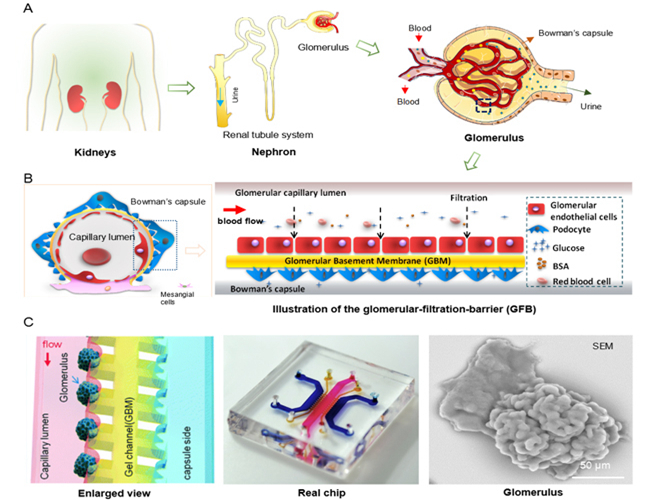Diabetic Nephropathy (DN) is one of the most serious chronic microvascular complications of diabetes mellitus. It affects almost 30-40% of people with diabetes and is the leading cause of end-stage kidney diseases requiring renal replacement therapy. Hyperglycemia secondary to DN might induce the major structural changes in the glomerulus, such as the thickening of the glomerular basement membrane, the impairment of glomerular cells within glomeruli. As such, it may greatly accelerate the understanding of DN pathophysiology and novel treatments by establishing a disease model of DN.
Dalian Institute of Chemical Physics microfluidic research group led by Prof. QIN Jianhua has made a progress on the establishment of a functional glomerulus-on-a-chip microdevice for mimicking a disease model of DN in vitro.

Schematic of glomerular structure and the glomerulus-on-a-chip microdevice (Image by WANG Li and YU Hao)
In this research, the authors provide the proof-of-principle for using a glomerulus-on-a-chip microdevice. It reconstitutes organ-level kidney functions to create a human disease model of early stage diabetic nephropathy on chip. The microfluidic device recapitulates the glomerular microenvironment. It consists of parallel channels lined by isolated primary glomerular microt issues that experience fluid flow to mimic the glomerular filtration barrier (GFB), including glomerular endothelial cells, 3D basement membrane and podocytes. The approach provides a novel strategy to maintain the survival of terminally differentiated glomerular cells. And it also visualizes the mobility of cells in real-time in 3D matrix, especially in a culture system in vitro, not possible by traditional 2D cell culture and animal models.
Furthermore, this device was used to reproduce high glucose-induced critical pathological responses in diabetic nephropathy as observed in humans. The results reveal that hyperglycemia plays a crucial role in the development of increased barrier permeability to albumin and glomerular dysfunction that lead to proteinuria. This organ-on-a-chip microdevice mimics the critical pathological responses of glomerulus. The characteristic of diabetic nephropathy provided a useful platform for studying the mechanism of diabetic nephropathy and developing an effective therapy in glomerular diseases.
The results were published in the journal of Lab on a Chip (Lab Chip. 2017,16; 17(10):1749-1760) . This study was supported by National Nature Science Foundation of China and The International Science and Technology Cooperation Program of China. (Text and Image by WANG Li and YU Hao)
Dr. LU Xinyi
Dalian Institute of Chemical Physics, Chinese Academy of Sciences,
457 Zhongshan Road, Dalian, 116023, China,
Tel: 86-411-84379201
E-mail: luxinyi@dicp.ac.cn